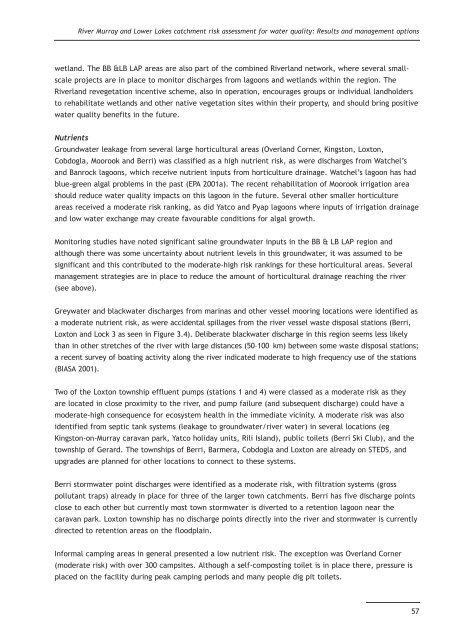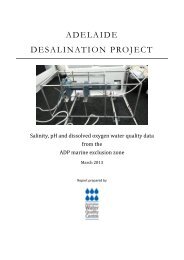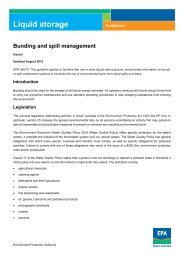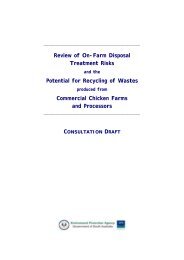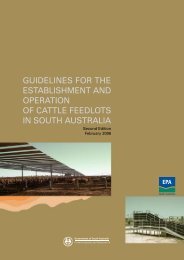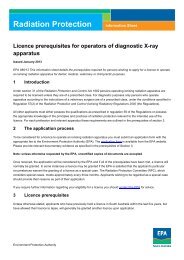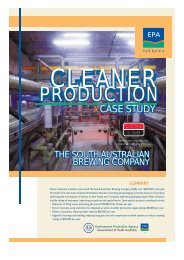2 Renmark to border LAP area assessment - EPA - Sa.gov.au
2 Renmark to border LAP area assessment - EPA - Sa.gov.au
2 Renmark to border LAP area assessment - EPA - Sa.gov.au
You also want an ePaper? Increase the reach of your titles
YUMPU automatically turns print PDFs into web optimized ePapers that Google loves.
River Murray and Lower Lakes catchment risk <strong>assessment</strong> for water quality: Results and management options<br />
wetland. The BB &LB <strong>LAP</strong> <strong>area</strong>s are also part of the combined Riverland network, where several smallscale<br />
projects are in place <strong>to</strong> moni<strong>to</strong>r discharges from lagoons and wetlands within the region. The<br />
Riverland revegetation incentive scheme, also in operation, encourages groups or individual landholders<br />
<strong>to</strong> rehabilitate wetlands and other native vegetation sites within their property, and should bring positive<br />
water quality benefits in the future.<br />
Nutrients<br />
Groundwater leakage from several large horticultural <strong>area</strong>s (Overland Corner, Kings<strong>to</strong>n, Lox<strong>to</strong>n,<br />
Cobdogla, Moorook and Berri) was classified as a high nutrient risk, as were discharges from Watchel’s<br />
and Banrock lagoons, which receive nutrient inputs from horticulture drainage. Watchel’s lagoon has had<br />
blue-green algal problems in the past (<strong>EPA</strong> 2001a). The recent rehabilitation of Moorook irrigation <strong>area</strong><br />
should reduce water quality impacts on this lagoon in the future. Several other smaller horticulture<br />
<strong>area</strong>s received a moderate risk ranking, as did Yatco and Pyap lagoons where inputs of irrigation drainage<br />
and low water exchange may create favourable conditions for algal growth.<br />
Moni<strong>to</strong>ring studies have noted significant saline groundwater inputs in the BB & LB <strong>LAP</strong> region and<br />
although there was some uncertainty about nutrient levels in this groundwater, it was assumed <strong>to</strong> be<br />
significant and this contributed <strong>to</strong> the moderate-high risk rankings for these horticultural <strong>area</strong>s. Several<br />
management strategies are in place <strong>to</strong> reduce the amount of horticultural drainage reaching the river<br />
(see above).<br />
Greywater and blackwater discharges from marinas and other vessel mooring locations were identified as<br />
a moderate nutrient risk, as were accidental spillages from the river vessel waste disposal stations (Berri,<br />
Lox<strong>to</strong>n and Lock 3 as seen in Figure 3.4). Deliberate blackwater discharge in this region seems less likely<br />
than in other stretches of the river with large distances (50–100 km) between some waste disposal stations;<br />
a recent survey of boating activity along the river indicated moderate <strong>to</strong> high frequency use of the stations<br />
(BIASA 2001).<br />
Two of the Lox<strong>to</strong>n <strong>to</strong>wnship effluent pumps (stations 1 and 4) were classed as a moderate risk as they<br />
are located in close proximity <strong>to</strong> the river, and pump failure (and subsequent discharge) could have a<br />
moderate-high consequence for ecosystem health in the immediate vicinity. A moderate risk was also<br />
identified from septic tank systems (leakage <strong>to</strong> groundwater/river water) in several locations (eg<br />
Kings<strong>to</strong>n-on-Murray caravan park, Yatco holiday units, Rili Island), public <strong>to</strong>ilets (Berri Ski Club), and the<br />
<strong>to</strong>wnship of Gerard. The <strong>to</strong>wnships of Berri, Barmera, Cobdogla and Lox<strong>to</strong>n are already on STEDS, and<br />
upgrades are planned for other locations <strong>to</strong> connect <strong>to</strong> these systems.<br />
Berri s<strong>to</strong>rmwater point discharges were identified as a moderate risk, with filtration systems (gross<br />
pollutant traps) already in place for three of the larger <strong>to</strong>wn catchments. Berri has five discharge points<br />
close <strong>to</strong> each other but currently most <strong>to</strong>wn s<strong>to</strong>rmwater is diverted <strong>to</strong> a retention lagoon near the<br />
caravan park. Lox<strong>to</strong>n <strong>to</strong>wnship has no discharge points directly in<strong>to</strong> the river and s<strong>to</strong>rmwater is currently<br />
directed <strong>to</strong> retention <strong>area</strong>s on the floodplain.<br />
Informal camping <strong>area</strong>s in general presented a low nutrient risk. The exception was Overland Corner<br />
(moderate risk) with over 300 campsites. Although a self-composting <strong>to</strong>ilet is in place there, pressure is<br />
placed on the facility during peak camping periods and many people dig pit <strong>to</strong>ilets.<br />
57


